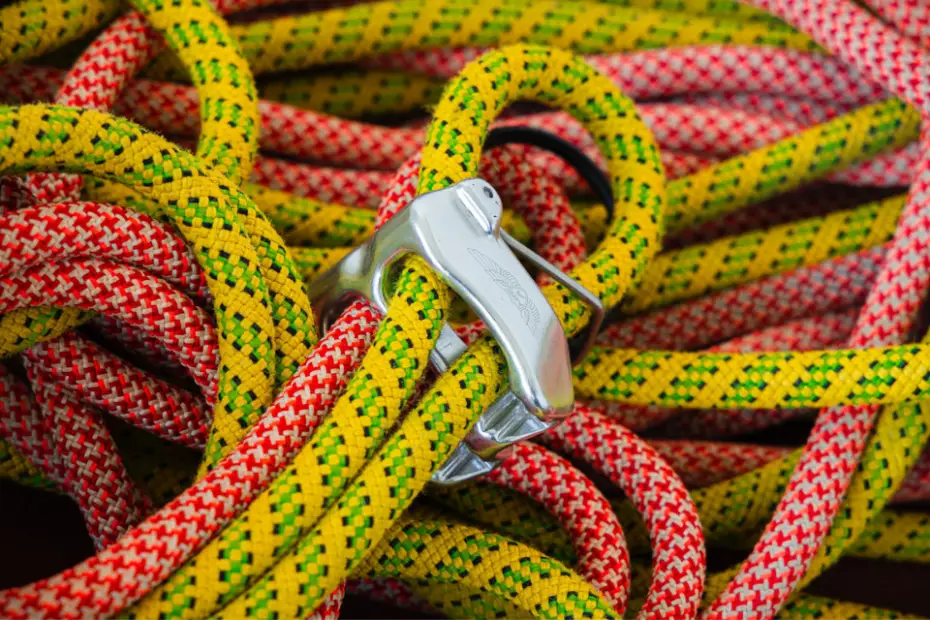Ever wondered what the difference is between dry and non-dry rope? Not sure which one is best for your preferred type of climbing? I certainly have! In this guide, I will look at the difference between dry rope and non-dry rope and help you know which one is the best for you to buy.
In a hurry? Here is a brief summary.
Dry rope is a rope that has been treated to make it as water-resistant as possible. Non-dry rope has not had the same treatment and is, therefore, more likely to absorb water when used in wet conditions.
As dry rope is more expensive than non-dry rope, people only tend to buy it if they are planning on climbing in conditions where they will encounter wetter weather, such as ice climbing or in places it is likely to rain. If you are only going to use indoor climbing walls, you won’t need dry rope and should save you money by purchasing non-dry rope.
Recommended Climbing Ropes
- 8.6mm width x 50m length
- Weighs 48g per metre
- Compatible with all belay devices
- Absorbs fall force well thanks to low impact force of 6.6 kN
- 8.1mm width x 50m length
- Weighs 44g per metre
- UIAA DRY hydrophobic treatment is ideal for use in wet environments
- Absorbs fall force well thanks to low impact force of 6.2 kN
What Is A Dry Rope?
Dry rope is a specially designed rope to be used in conditions when your rope is likely to get wet.
Woven in such a way as to reduce water absorbance, as well as being impregnated with a fluoropolymer-based solution, dry rope is especially useful if you are climbing in wet conditions, such as ice climbing or climbing through snowy conditions.
Dry rope is typically used by mountain rescue and other emergency services, due to its durability and water resistance providing a better all-round performance whatever the conditions.
What Is A Non-Dry Rope?
Unlike dry rope, non-dry rope has not been treated to protect is against water absorption, nor is it woven in such a way as to help protect it from wet conditions. As a result, non-dry rope doesn’t repel water, as well as dry rope, does.
Whilst this will make the rope less durable over time, the main advantage to non-dry rope is that it is significantly cheaper than dry rope, priced at around £1.50 per metre vs. £1.80 per metre for dry rope at Decathlon.
Do Dry Treated Ropes Last Longer?

Now we know what the difference is between the two in terms of how they are made, the question really is, which one will last longer.
To answer this question effectively, we need to consider the conditions in which the rope will be used. In brief:
- Outdoor climbing = Dry rope
- Indoor climbing = Non-dry rope
Below is a little more detail why for each one.
Outdoor Climbing
If you are planning on using the rope in outdoor conditions, where it will be subjected to different weather conditions, rain and potentially ice as well, then a dry rope will definitely last longer than a non-dry rope. This is because the water will not penetrate the fibres of the material and make them weaker over time.
As well as the weather, you will also be contending with grit and dirt when climbing outdoors. On the whole, dry rope is more tightly woven, making it difficult for small particles to penetrate the fibres. This will therefore reduce the amount of rubbing in the fibres of the rope and should help to make the rope last longer.
Indoor Climbing
Indoor climbing is very different to outdoor climbing as you are less likely to have to deal with the weather (depending on how well the building is maintained!).
For indoor use, your rope is less likely to be subjected to the wet conditions of the outdoors, as well as encountering far less grit. This means that the benefits of a dry rope are not as important when climbing indoors and instead a non-dry rope should suffice.
Can I Climb With A Wet Rope?
Having read the above you are probably now wondering whether your non-dry rope, which got wet your last climbing trip is ruined.
Well fear not, even though your rope is wet, you are still able to climb with it. However, you will find that the performance of the rope is affected if it is wet compared to when dry.
The following are a few of the issues you might encounter:
Weight
A wet rope is a heavy rope. It’s as simple as that.
That might not sound like too much of an issue, but if you are carrying all your gear over tricky terrain and a decent distance to get to your climbing spot, having a heavy rope is going to be quite annoying.
Loss Of Dynamic Properties
If you have a climbing rope that is designed to stretch when pulled tight, in the case that you fall, for instance, you will find that a wet rope loses that elasticity and won’t stretch as much as when it is dry.
This will mean that if you do fall and your rope is wet, whilst you’re still safe from hitting the ground, your fall won’t be as soft as it normally would be.
Potential Loss Of Performance
Now your rope is wet and has lost some of its dynamic properties, each time you put extra forces through the rope when falling, you are weakening the rope overall.
Put simply, the life of a wet rope is reduced significantly compared to if you keep it dry.
If you continue using your rope that has been saturated with water, you will need to check it regularly for signs of wear and tear a lot more to ensure that it is safe to use in the future.
Which Rope Should I Buy?

As has been mentioned earlier, the rope you should buy will depend on the type of climbing you are most likely going to be doing.
If you are only doing indoor climbing, you should save your money and buy non-dry rope as you are unlikely to be exposed to the elements as much.
If you are solely going to be climbing outdoors, a dry rope is a good choice as you will be able to climb in pretty much any conditions you are likely to encounter.
For those looking to blend indoors and outdoors, I would consider the weather you are most likely to encounter. If climbing in the summer outdoors only you could probably get away with a non-dry rope. Otherwise buy a dry rope.
Summary
So there you go, now you know the difference between dry and non-dry rope, as well as which one you should use in different conditions.
When it comes to buying your climbing rope, just make sure you consider the conditions you will be climbing in before making a purchase.
If in doubt, for maximum flexibility, buy a dry rope!
If you liked this guide, please share it on Pinterest. Also, please check out our other guides to all things outdoors.
Happy Climbing!





